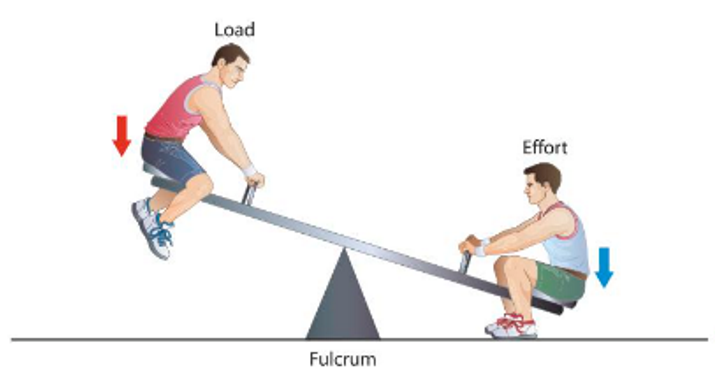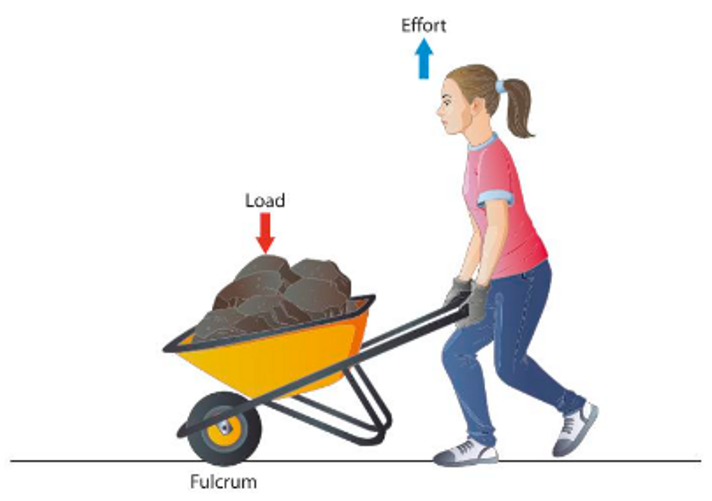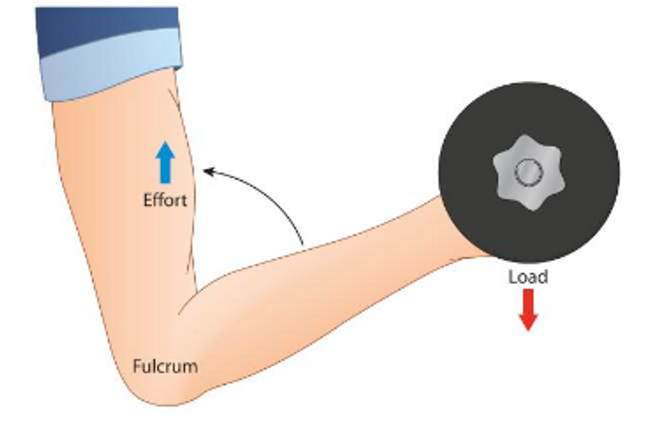CHAPTER 2
types of levers
lever - a rigid bar that turns about an axis to create movement
three types of levers
- first class lever
- second class lever
- third class lever
all make use of fulcrum, load and effort
fulcrum - the point at which a lever turns or is supported (aka axis)
load - the weight or ‘resistance’ that the lever must move
effort - force required to move the load (from muscles)
first class levers
fulcrum midway between effort and load

second class levers
load between fulcrum and effort (large load moved with low effort)

third class levers
effort between fulcrum and load (large range of movement with low effort)

mechanical advantage
load arm - distance from load to fulcrum
effort arm - distance from effort to fulcrum
when effort arm is longer than load arm, lever has high mechanical advantage (move large loads with low effort)
- 2nd class levers always have high mechanical advantage
when load arm is longer than effort arm, lever has low mechanical advantage (not able to move heavy loads)
- 3rd class levers always have low mechanical advantage
1st class levers can have high or low mechanical advantage
basic movements
flexion - takes place when angle of the bones at the joint decreases
- can occur at the shoulder, elbow, hip and knee
extension – Takes place when the angle of the bones at the joint increases
- can occur at the shoulder, elbow, hip and knee
abduction – The movement of a limb away from the midline of the body
- can occur at the shoulder and the hips
adduction – opposite movement to abduction. Takes place when the limb moves towards the midline of the body
- it can occur at the hips and shoulders
circumduction – Combination of flexion, extension, adduction and abduction
- can occur at the shoulder joint, as the arm moves in a circle
dorsiflexion – Takes place at the ankle joint when the foot flexes upwards
plantar flexion – Takes place at the ankle joint when the foot flexes downwards
rotation – Circular movement where part of the body turns while the rest remains still.
- it can occur at the hips and shoulders
Planes – Imaginary line that divides the body into 2 halves. A movement occurs in a plane
There are 3 types of planes
· Frontal
o Divides the body front and back
· Transverse
o Divides top and bottom
· Sagittal
o Divides body left and right
Axes – An imaginary straight line around which the body rotates
Three types of axes
· Sagittal
o Runs horizontally through the body from front to back (through belly button)
o Allows adduction and abduction
· Longitudinal
o Runs vertically through the body from head to toe
o Rotation of the body in an upright position
· Transverse
o Runs horizontally through the body from left to right at the hips
o Flexion and extension